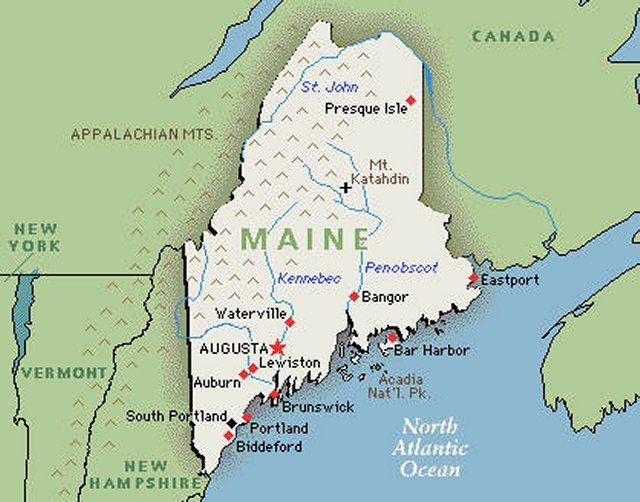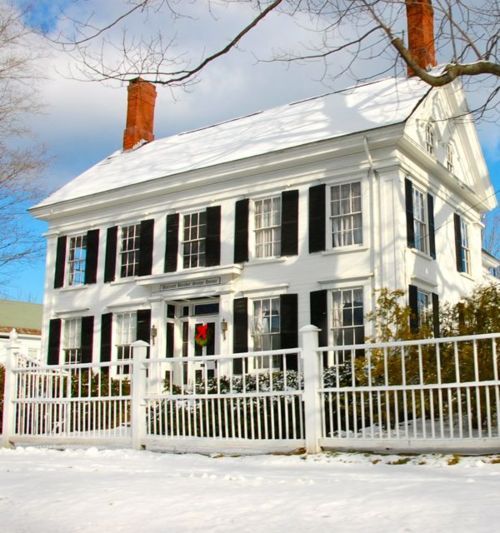Harriet Beecher Stowe and her husband, Calvin Ellis Stowe, lived in this house for a short while. The house is also remarkable for having been the home of Henry Wadsworth Longfellow when he was a student. Today it is owned by Bowdoin College and a National Historical Landmark.  You can find it on Federal Street in Brunswick, Maine. Brunswick was settled in 1628 and is considered to be the gateway community to the magnificent middle coast of Maine. Since Pequod is located fairly nearby, Rhe Brewster would probably pass through this historic town fairly regularly. The old architecture alone would be a great draw for her.
You can find it on Federal Street in Brunswick, Maine. Brunswick was settled in 1628 and is considered to be the gateway community to the magnificent middle coast of Maine. Since Pequod is located fairly nearby, Rhe Brewster would probably pass through this historic town fairly regularly. The old architecture alone would be a great draw for her.
The Greek Revival style home was built in 1806 for Franklin and Mary Chamberlin; he was an attorney and state politician. It was originally known as the Stonemore House and combines architectural details like the steep hip-roof and graceful exterior trim with bay windows and porches on each side. The house has a large interior of 4500 square feet, and the facade makes the house appear smaller than it actually is.
details like the steep hip-roof and graceful exterior trim with bay windows and porches on each side. The house has a large interior of 4500 square feet, and the facade makes the house appear smaller than it actually is.
The Stowes rented the house when Calvin Stow was hired as a professor at Bowdoin in 1850. Mrs. Stowe went to Brunswick ahead of him to set up the house, while he finished his teaching at the Lane Theological seminary in Cincinnati. She was six months pregnant at the time and arrived in May with the couple’s three oldest children, in the middle of a storm. Luckily the house had been prepared for their arrival. Mrs. Stowe missed her husband and wrote him that the house was a rattletrap that the wind shook, creating many noises – screeching, snapping, cracking and groaning. The last of their seven children, Charley Stowe, was born in the house on July 8, 1850.
Rent for the home was $125, higher than expected, and Mrs. Stowe wrote for several magazines, including the New-York Evangelist and the National Era in Washington, D.C. to offset that expense. Her best-selling anti-slavery novel, Uncle Tom’s Cabin, was written in this house and was based on her experiences from visiting Kentucky and on her interviews with fugitive slaves. The book catapulted her to international celebrity. There is a story that Mrs. Stowe actually wrote the book in a rented room in a house on College Street, to get away from the noise of her children, but this has never been proven. The Stowes stayed in the Federal Street house for only two years, but Mrs. Stowe later remarked those two years were the healthiest and happiest of her life.
At some point, the home was altered and became a restaurant and an inn, with a front desk and gift shop on the first floor and private rooms on the second floor. It was expanded several times to include an attached barn, several ells, and a 54-unit motel. The complex was purchased in 2001 for $1.3 million by Bowdoin College, which rehabilitated the motel for use as a student dormitory. The main house is not currently in use nor open to the public.
![]()

lovely!
Thanks for stopping by – even more wonderful to be sailing her!
Sorry – my computer jumped to another post about the Grace Bailey – I need to be more careful!
Now that house i recall from my brief visit there.
These continue to be fine posts, Noelle – Thank You.
My best to You
john
Thanks, John. I’m sort of into houses from a course I took in college called Table and Chairs by the students. Real name: The Early American Home and its Furnishings!
Wonderful to read about the places our literary masters lived in. A gem of a post, Noelle. Pity it can no longer be visited. Have you been inside?
Nope – I think I would have to get permission from the college – but maybe for a future post?
An interesting post on Harriet Beecher Stowe. I’m trying to recall… wasn’t her brother a minister?
She’s always seemed such an earnest person to me. Many reformers were. I appreciate their work, but find them stuffy. I wonder, did they laugh and frolic at times with children or just write tracts and attend meetings? (Well, she had time for some other pursuits considering she had seven children! 😀 )
I think she had a backbone of steel, Kate – traveling with all her children to Maine and managing the house and the children for a half year until her husband arrived. I got the feeling that she loved her children, but had another calling as well, in which luckily (for that day) she could indulge.
It would be wonderful if it were made open to the public. I think it would attract a large crowd since there’s quite a bit of history there. 🙂
Diane, I’m really going to have to follow up on this at some point – find out what’s planned and if I could be given permission to see the inside. Being a writer opens doors!
You are really making me want to visit Maine! It’s too bad this house is not open to the public but can you imagine living there as a student!
Especially with a fellow student named Henry Wadsworth Longfellow!
Yeah, you must get inside and take us there via your blog. Sure the story of her writing hasn’t been proven, but stories do start somewhere, even if the truth is altered somewhat throughout the years. Fabulous post, Noelle.
Thanks, Sylvia!
That is a big house! I would love to take a tour through it. Its nice that old historic buildings are being preserved.
Not nearly enough are being preserved, unfortunately. There was a period – in the 1950’s and 60’s – when a lot of old homes got torn down. Now you have to be 1) crazy, 2) rich as Croesus, or 3) the ultimate home repair person to take on some of these old places. If I were younger, I’d do it in a cold minute!
Wouldn’t surprise me if she escaped down the street to write. My grandmother was a world class concert pianist and she had a silent practice piano stashed under the house in the downstairs laundry but she’d also drive round to her aunt’s place after the children were in bed to practice. She really needed to do 4-5 hours of practice a day, which was no minor undertaking with 7 children.
Interesting observation! Apparently there is no proof that she wrote in the other house, just legend and rumor, but with all those kids, it is entirely possible.
I’d certainly escape. Actually, I’m about to escape for a walk along the waterfront with the dogs. Kids may or may not join me.